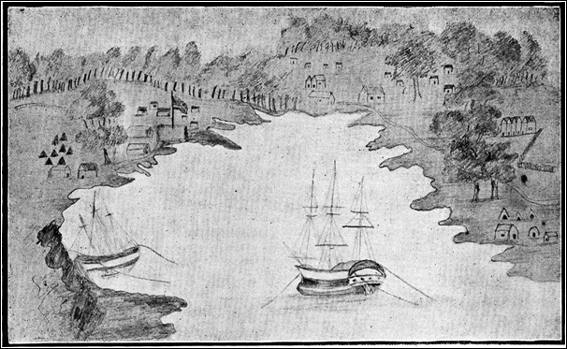SYDNEY COVE
It has been said that the streets of Sydney were laid out by the bullock wagons of the early settlers. This is not correct as in the first place there were no bullock wagons in the First Fleet, and such was the primeval condition of the shores of Sydney Cove then that, even if there had been wagons, the contour of the ground itself prescribed where the main roads must run. Let us glance for a moment at the shores as Governor Phillip saw them when he first rowed into the Cove. We are able to do this because Captain Hunter very kindly drew a sketch of the settlement in August 1788, i.e., seven months after its establishment, and that sketch is reproduced on page 4. Contemporary records and a study of the configuration of the ground to-day will assist us.

On his right hand, as he entered the cove, Phillip saw a steep, rocky hill extending from what came to be known as Dawes Battery to Grosvenor street; thence the hill continued southwards, but with a less rocky and rugged contour. On his left arose another hill, at first with an abrupt rise from the water, then changing to a gentler slope as it reached the vicinity where the Custom House now stands, and matching the opposite hill as it ran to the south. In the hollow between these hills ran a little purling brook—”a run of freshwater which stole silently along through a very thick wood, the stillness of which had then for the first time since the creation been interrupted by the rude sound of the labourer’s axe, and the downfall of its ancient inhabitants; a stillness and tranquility which from that day were to give place to the voice of labour, the confusion of camps and towns, and, the busy hum of its new possessors.” Thus wrote a man—David Collins—who landed from the First Fleet and saw in its pristine beauty what was afterward known as the Tank Stream. Collins refers to a “thick wood,” and Hunter’s drawing, although the ground was cleared in part when he drew his sketch, shows us that the slopes of the hills were thickly wooded.
In the woods must have grown some giant trees, for, in the “Sydney Gazette” of August 7th, 1803, it is announced that “the military have completed the streets in their respective districts”. They have removed from their places of nativity thirty-two stumps of trees, many of which were of monstrous bulk. One, in particular, deserves remark. Its circumference measured nine yards, and employed 16 men six days to loosen and bury it in a gulph that was necessarily prepared close to the spot on which it grew.” The tree required 90 men to roll it into the “gulph.” This giant stood in the vicinity of the George street of today.
